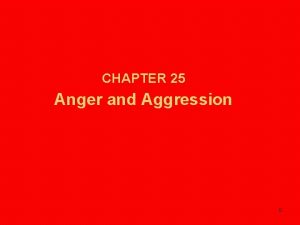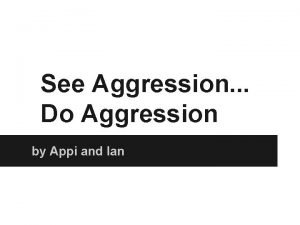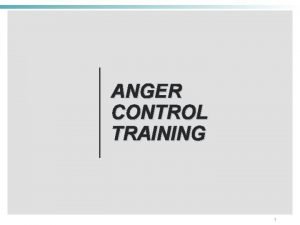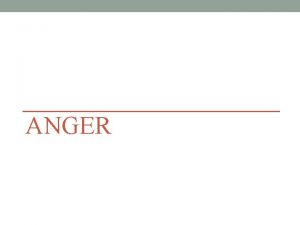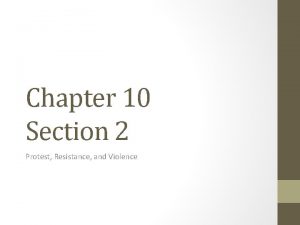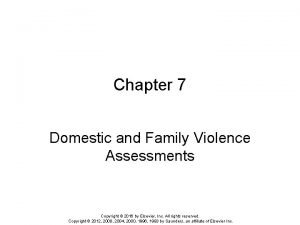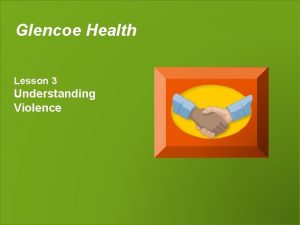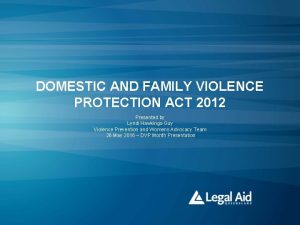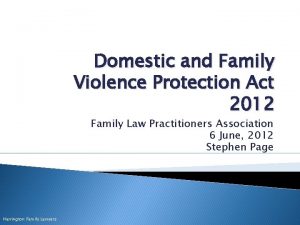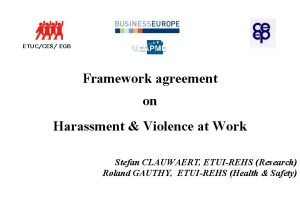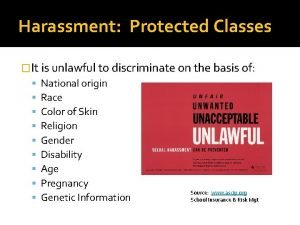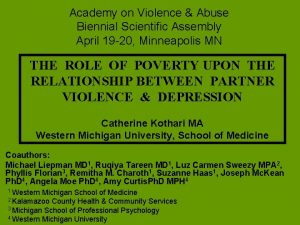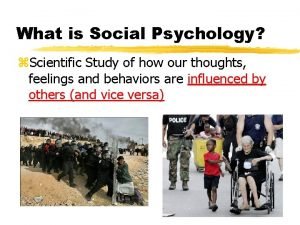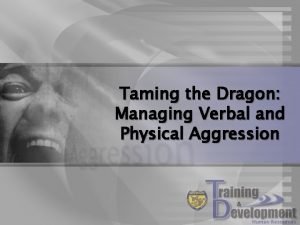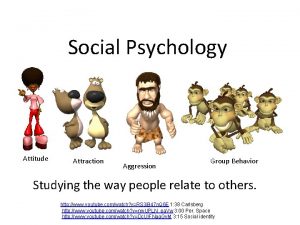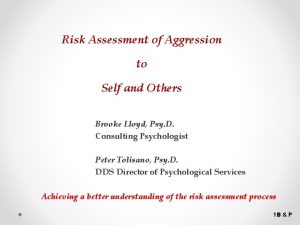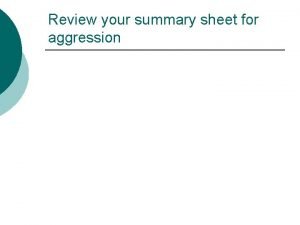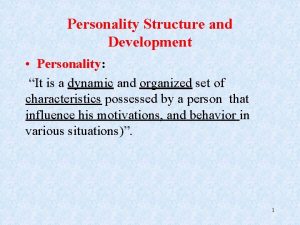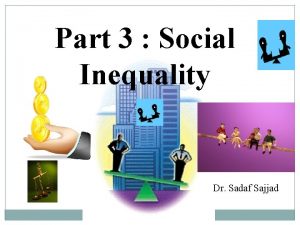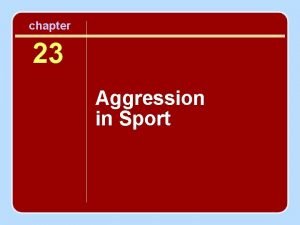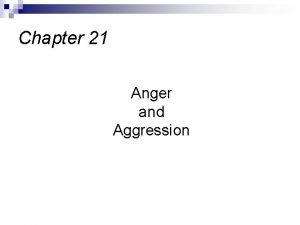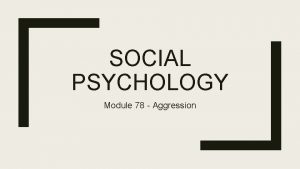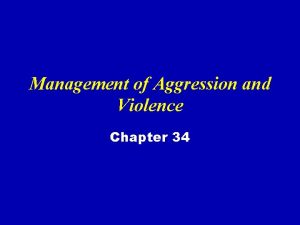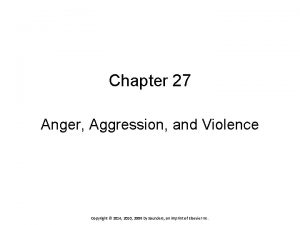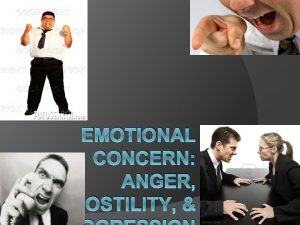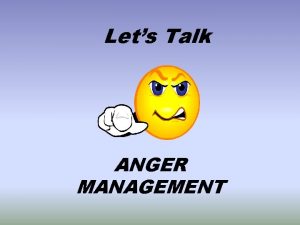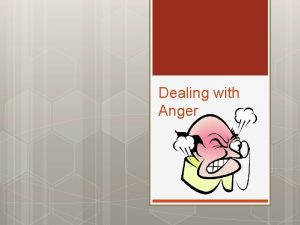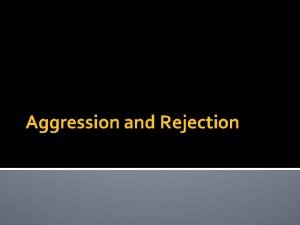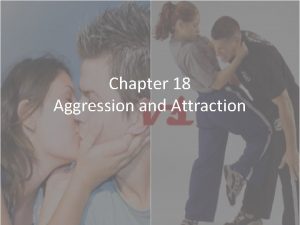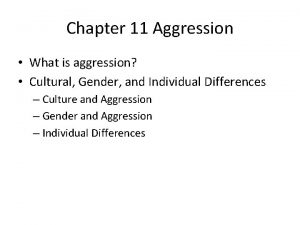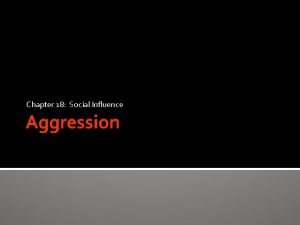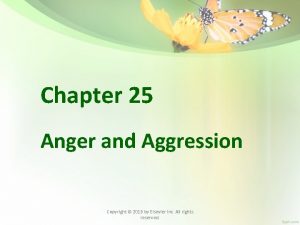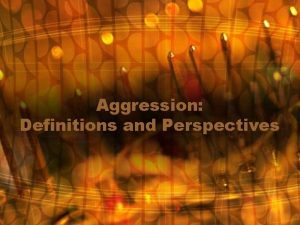CHAPTER 27 Anger Aggression and Violence 1 Anger
































- Slides: 32

CHAPTER 27 Anger, Aggression, and Violence 1

Anger and Aggression • Anger • An emotional response to frustration of desires, threat to one’s needs (emotional or physical), or a challenge • Aggression • Action or behavior that results in verbal or physical attack 2

Case Study Your new patient, Mr. Oswald, is assigned to your unit after getting into a fight outside a family restaurant. He got into an argument with a family, saying they threatened him, but witnesses were able to attest that the family had, in fact, said nothing to him at all and had, until he approached them in anger, barely noticed him in the parking lot. Mr. Oswald is a veteran with a history of posttraumatic stress disorder (PTSD) and comorbidities of depression and intermittent psychotic episodes. He does not appear to have a substance abuse disorder. Copyright © 2018, Elsevier Inc. All rights reserved. 3

Epidemiology • In the hospital, violence is most frequent in • • Psychiatric units Emergency departments Geriatric units Obstetrical units 4

Comorbidities • Posttraumatic stress disorder (PTSD) • Substance abuse disorders • Coexists with • • Depression Anxiety Psychosis Personality disorders 5

Etiology • Biological factors • Areas of the brain • Neurotransmitters • Predisposition 6

Etiology Continued • Psychoanalytical Theory • Sense of control over life is threatened causing trauma • Social Learning theory • Children learn aggression by imitating others • People repeat behavior that is rewarded • Cognitive theory • Perceived assault on areas of personal domain, values, moral codes, and protective rules can lead to anger 7

Stages of Anger and Aggression Feeling of vulnerability $ Uneasiness $ Anxiety $ Anger $ Aggression $ Violence 8

Assessment • Trauma-informed care • Focus on patients’ past experiences of violence or trauma and the role aggression currently plays in their lives 9

Assessment for Potential for Anger and Aggression • History of violence is the single best predictor of future violence • Demographic risk factors • Male • Aged 14 to 24 years • Low socioeconomic status • Low support system • Past prison 10

Feelings That May Precipitate Anger • Discounted • Embarrassed • Frightened • Found out • Guilty • Humiliated • Hurt • Ignored • Inadequate • Insecure • Unheard • Out of control of the situation • Rejected • threatened • Tired • Vulnerable 11

Situations, Signs and Symptoms that Usually Precede Violence • Limit setting by the nurse/staff • Hyperactivity • Increase in anxiety and tension • Verbal abuse of others • Very loud or very soft voice • Absolute silence • Intoxication with alcohol or drugs • Possession of a weapon • Recent history of violence • Isolation 12

Milieu Characteristics Conductive to Violence • Overcrowding • Staff inexperience • Provoking or controlling behaviors by staff • Lack of limit setting • Random taking away of privileges 13

Nursing Self-Assessment • Knowledge of personal responses to anger and aggression • Choice of words • Tone of voice • Nonverbal communication • Personal triggers • Personal sense of competence • Without self-knowledge, nurses are likely to make impulsive, emotion-based responses that are nontherapeutic and may be harmful 14

Techniques for the Nurse to be Able to Respond Calmly • Deep breathing • Relaxation of muscles not in use • Empathetic interventions 15

Case Study In the unit Mr. Oswald’s paranoia continues and he becomes agitated and threatens to assault another staff person. He tells you, “You’re the only one I think I can trust. But can I? Are you going to take their side? ” Copyright © 2018, Elsevier Inc. All rights reserved. 16

Audience Response Question Select the best initial intervention for Mr. Oswald at this point. A. B. C. D. Say, “If you do not calm down, seclusion will be needed. ” Address him with simple directions and a calming voice. Help him focus by rubbing his shoulders. Offer him a dose of antipsychotic medication. Copyright © 2018, Elsevier Inc. All rights reserved. 17

Case Study • A new nurse asks a coworker which patients are most likely to become aggressive or angry. • What are some risk factors that may predict violent behavior? 18

Nursing Process (continued) • Nursing diagnoses • Ineffective coping • Stress overload • Risk for self-directed violence • Risk for other-directed violence 19

Nursing Process (continued) • Outcomes identification (Table 27. 1) • Identifies when angry • Identifies alternates to aggression • Refrains from verbal outbursts • Maintains self-control without supervision • Upholds contract to restrain aggressive behaviors • Reports feelings of calmness and acceptance 20

De-escalation Techniques • Respond as early as possible • Maintain the patient’s self-esteem and dignity • Maintain calmness (your own and the patient’s) • Identify stressors and stress indicators • Use calm, clear tone of voice • Tell patient you are concerned and want to listen • Establish what the patient considers to be his or her need • Be goal oriented • Reduce environmental stimuli (control the environment) 21

De-escalation Techniques Continued • Maintain a large personal space • Avoid verbal struggles • Give several clear options (choices) • Utilize non-aggressive posture • Use genuineness and empathy • Attempt to be confidently aware • Be assertive, not aggressive • State expectations for patient’s behavior • Assess for personal safety 22

De-escalation Techniques Continued • Patients with healthy coping who are overwhelmed • Validation • Empathy • ID feeling • Patients with marginal coping skills • Anger can move quickly from anxiety to aggression • External locus of control • Strategies for the persistently verbally abusive client 23

Pharmacological interventions • Offer PRN medication to alleviate acute symptoms (Table 27. 2) • Antianxiety agents • Antipsychotics • Long-term management of chronic aggression (Table 27. 3) 24

Audience Response Question Mr. Oswald becomes increasingly agitated, and when you come back from break, you find out he wants to talk to you alone. Your response is to A. Respect his privacy and see him alone. B. Do not speak to him in private; it’s time for the team to confront him (calmly) as a group. C. Ask for him to be put in restraints first or take security staff with you. D. Go speak to him in a nonconfrontational way, but ensure that there are other staff nearby for backup. Copyright © 2018, Elsevier Inc. All rights reserved. 25

Case Study (continued) • What are some ways this new nurse can keep himself or herself safe while working? 26

Nursing Process (Cont. ) Implementation • Health teaching and health promotion • Case management • Teamwork and safety • Use of restraints or seclusion (next slides) 27

Seclusion or Restraints • Seclusion • Involuntary confinement alone in a room that the patient is physically prevented from leaving • Restraints • Any manual method, physical or mechanical device, material, or equipment that restricts freedom of movement 28

Guidelines for Use of Mechanical Restraints (Box 27. 3) • Indications for use • Legal requirements • Documentation • Observation • Release procedure 29

Postassaultive Stage • Staff should review incident with patient and colleagues • Identify precursors/stressors • Review alternate ways of responding in future 30

Audience Response Questions Finally, Mr. Oswald is restrained. As his nurse, what is your first priority? A. Debrief the patient B. Ensure the patient’s safety C. Administer a sedating medication D. Obtain an order from the health care provider E. Document reason for restraint placement and least restrictive measures taken 31

Audience Response Questions Which patient behavior is a criterion for mechanical restraint? A. Screaming profanities B. Assaulting a staff person C. Refusing a medication dose D. Throwing a pillow at another patient E. Persistent banging of head against the wall 32
 Chapter 27 anger aggression and violence
Chapter 27 anger aggression and violence Assault cycle stages
Assault cycle stages See aggression do aggression
See aggression do aggression See aggression do aggression
See aggression do aggression Anger replacement training
Anger replacement training Anger vs aggression
Anger vs aggression Behavior chain
Behavior chain Chapter 9 resolving conflicts and preventing violence
Chapter 9 resolving conflicts and preventing violence Chapter 10 section 2 protest resistance and violence
Chapter 10 section 2 protest resistance and violence Chapter 9 resolving conflicts and preventing violence
Chapter 9 resolving conflicts and preventing violence Ebb tide tackle
Ebb tide tackle Chapter 7 domestic and family violence assessment
Chapter 7 domestic and family violence assessment Chapter 10 section 2 protest resistance and violence
Chapter 10 section 2 protest resistance and violence Chapter 9 lesson 3 understanding violence
Chapter 9 lesson 3 understanding violence Modifiers of human act ignorance
Modifiers of human act ignorance Domestic and family violence protection act 2012
Domestic and family violence protection act 2012 Gandhi king and mandela what made non-violence work dbq
Gandhi king and mandela what made non-violence work dbq S68r family law act
S68r family law act Framework agreement on harassment and violence at work
Framework agreement on harassment and violence at work Workplace violence and harassment quiz answers
Workplace violence and harassment quiz answers Academy on violence and abuse
Academy on violence and abuse Self fulfilling prophecy meaning
Self fulfilling prophecy meaning Outline the role of genetic factors in aggression
Outline the role of genetic factors in aggression Examples of verbal aggression
Examples of verbal aggression Frustration aggression principle
Frustration aggression principle Mere exposure effect psychology
Mere exposure effect psychology Mauritania white moors
Mauritania white moors Types of aggression in psychology
Types of aggression in psychology Aggression risk assessment
Aggression risk assessment Theories of aggression
Theories of aggression Aggression defence mechanism
Aggression defence mechanism Instrumental aggression
Instrumental aggression Types of aggression in sports
Types of aggression in sports

